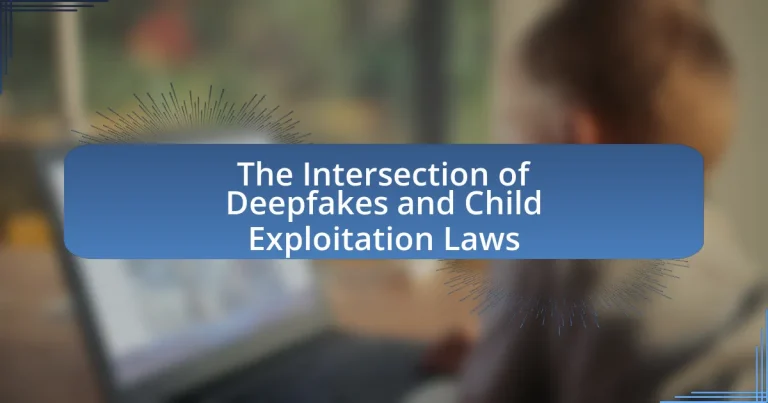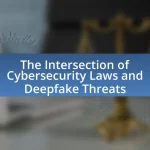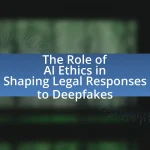Deepfakes are synthetic media generated through artificial intelligence that can create realistic but fabricated content, raising significant concerns in the context of child exploitation laws. This article examines how deepfake technology can be misused to produce non-consensual and harmful representations of minors, violating legal protections against child exploitation. It discusses the technologies behind deepfakes, their impact on the creation of harmful content, and the ethical implications of their use. Additionally, the article outlines current child exploitation laws, the challenges faced by law enforcement in combating deepfake-related crimes, and the role of technology companies in preventing exploitation. Finally, it addresses the need for legislative changes and best practices to safeguard vulnerable populations from the risks associated with deepfakes.
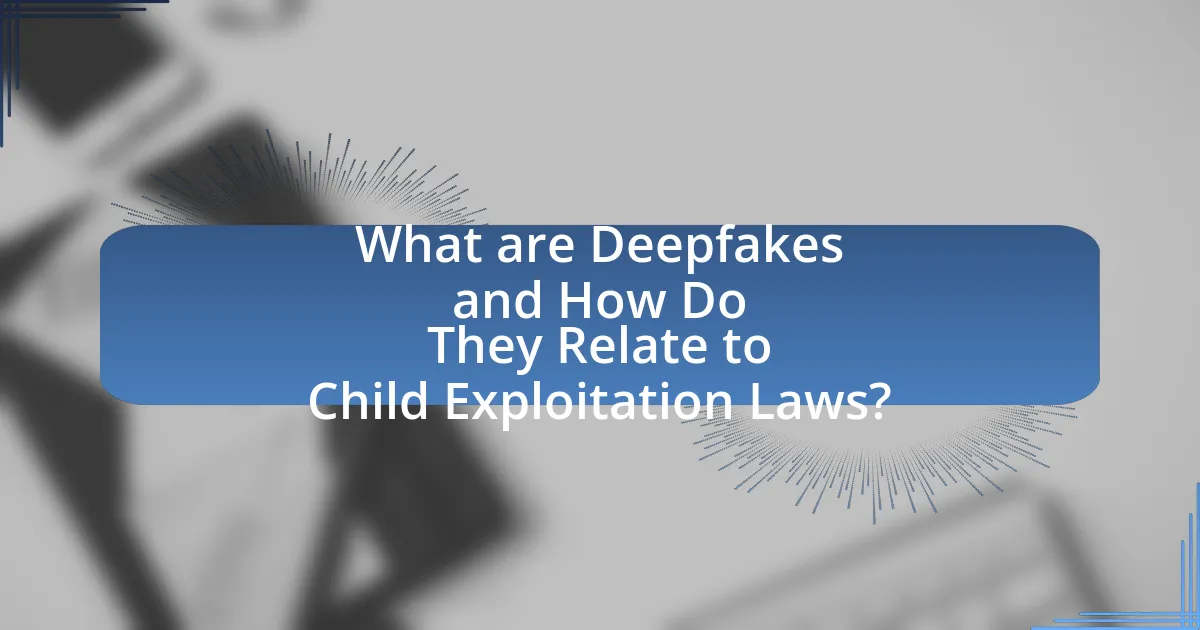
What are Deepfakes and How Do They Relate to Child Exploitation Laws?
Deepfakes are synthetic media created using artificial intelligence that can manipulate images, audio, or video to produce realistic but fabricated content. They relate to child exploitation laws as they can be used to create non-consensual and harmful representations of minors, potentially violating laws designed to protect children from exploitation and abuse. For instance, the use of deepfake technology to create child pornography is illegal under various statutes, including the Protect Act in the United States, which criminalizes the production and distribution of child exploitation materials. This intersection raises significant legal and ethical concerns, as the technology can facilitate the exploitation of vulnerable individuals while challenging existing legal frameworks to address such abuses effectively.
What technologies are used to create deepfakes?
Deepfakes are primarily created using artificial intelligence technologies, specifically deep learning techniques such as Generative Adversarial Networks (GANs). GANs consist of two neural networks, a generator and a discriminator, that work together to produce realistic synthetic media by learning from large datasets of images and videos. This technology enables the manipulation of facial features and expressions in videos, making it possible to create highly convincing fake content. The effectiveness of GANs in generating deepfakes has been demonstrated in various studies, highlighting their ability to produce outputs that can be indistinguishable from real footage.
How do these technologies impact the creation of harmful content?
Deepfake technologies significantly enhance the creation of harmful content by enabling the realistic manipulation of images and videos, which can be used to produce misleading or exploitative material. These technologies allow individuals to create non-consensual explicit content, often targeting minors, thereby exacerbating issues related to child exploitation. Research indicates that the rise of deepfakes has led to an increase in incidents of online harassment and abuse, with a study from the University of California, Berkeley, highlighting that 96% of deepfake content is non-consensual pornography. This alarming statistic underscores the potential for deepfakes to facilitate harmful actions, making it easier for perpetrators to exploit victims without their knowledge or consent.
What are the ethical implications of using deepfake technology?
The ethical implications of using deepfake technology include the potential for misinformation, manipulation, and harm to individuals’ reputations. Deepfakes can create realistic but fabricated videos that may mislead viewers, leading to false narratives and public distrust. For instance, a study by the University of California, Berkeley, found that deepfake videos could significantly influence public opinion and political outcomes, highlighting the risk of their use in disinformation campaigns. Additionally, deepfakes can be exploited for malicious purposes, such as creating non-consensual explicit content, which raises serious concerns regarding consent and privacy rights. The misuse of this technology can contribute to harassment and exploitation, particularly affecting vulnerable populations, including children.
What are the current child exploitation laws in relation to digital content?
Current child exploitation laws regarding digital content primarily focus on the prohibition of child pornography and the exploitation of minors through digital means. In the United States, the Protect Act of 2003 criminalizes the production, distribution, and possession of child pornography, including digital formats. Additionally, the Children’s Online Privacy Protection Act (COPPA) mandates parental consent for the collection of personal information from children under 13, aiming to protect minors in digital environments.
Internationally, the Optional Protocol on the Sale of Children, Child Prostitution and Child Pornography, adopted by the United Nations, obligates signatory countries to criminalize child exploitation in all forms, including digital content. These laws are enforced through various agencies, including the FBI’s Internet Crimes Against Children Task Force, which investigates online exploitation cases.
The effectiveness of these laws is supported by statistics indicating a rise in prosecutions related to online child exploitation, reflecting a growing recognition of the need for stringent measures against digital abuses.
How do these laws define child exploitation in the digital age?
Laws define child exploitation in the digital age as any act that involves the sexual abuse, exploitation, or trafficking of minors through digital platforms. This includes the creation, distribution, or possession of child sexual abuse material, as well as the use of technology to groom or manipulate children for sexual purposes. For instance, the Protecting Children from Online Sexual Exploitation Act of 2018 specifically addresses online platforms’ responsibilities to prevent child exploitation and mandates reporting of suspected abuse. Additionally, the rise of deepfake technology has prompted legal discussions about the potential for digitally manipulated images or videos to exploit children, further complicating the legal landscape surrounding child protection in the digital realm.
What penalties exist for violations of child exploitation laws?
Violations of child exploitation laws can result in severe penalties, including lengthy prison sentences, substantial fines, and mandatory registration as a sex offender. For instance, federal laws in the United States impose penalties ranging from 5 to 30 years in prison for offenses such as child pornography and trafficking, depending on the severity of the crime. Additionally, state laws may impose further penalties, which can include life sentences for particularly egregious offenses. These penalties are designed to deter exploitation and protect vulnerable children from harm.
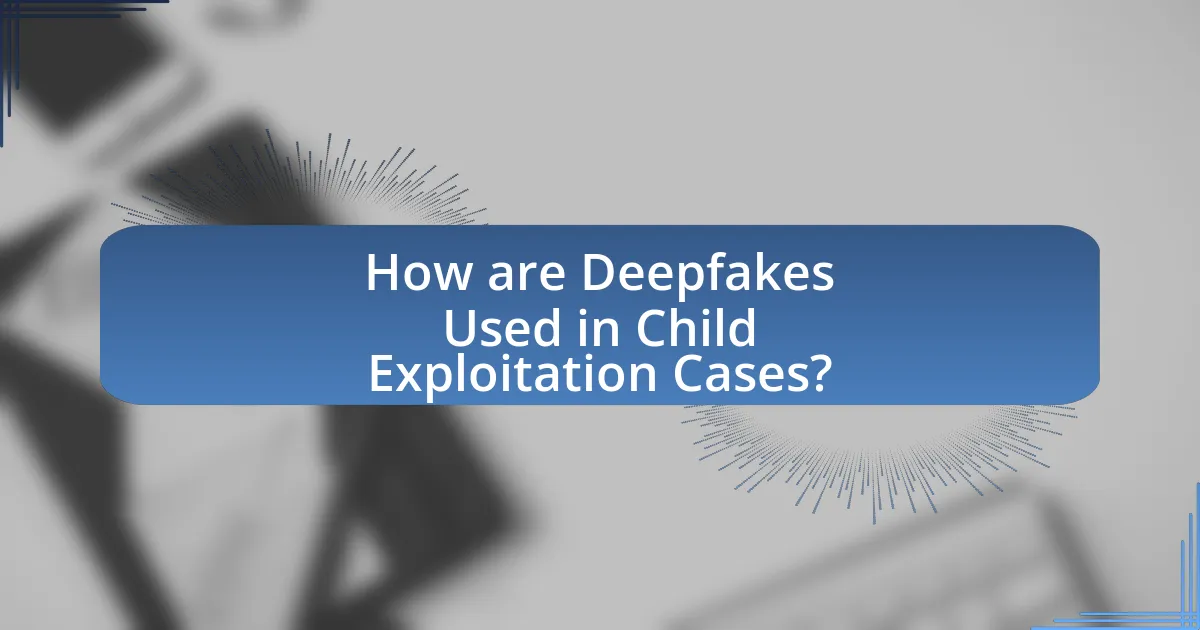
How are Deepfakes Used in Child Exploitation Cases?
Deepfakes are used in child exploitation cases primarily to create misleading and harmful content that depicts minors in sexual situations, often without their consent. This technology allows perpetrators to manipulate images and videos, making it appear as though children are engaging in inappropriate activities, which can be used for blackmail, distribution of child pornography, or to groom other victims. The rise of deepfake technology has complicated law enforcement efforts, as it blurs the lines between real and fabricated content, making it challenging to identify and prosecute offenders. According to a report by the Internet Watch Foundation, there has been a significant increase in the use of deepfake technology in child sexual exploitation, highlighting the urgent need for legal frameworks to address this emerging threat.
What are the common methods of using deepfakes for exploitation?
Common methods of using deepfakes for exploitation include creating non-consensual pornography, impersonating individuals for fraud, and generating misleading content for manipulation. Non-consensual pornography involves using deepfake technology to superimpose someone’s face onto explicit content without their consent, which can lead to severe emotional and reputational harm. Impersonation for fraud occurs when deepfakes are used to mimic someone’s likeness in order to deceive others, often for financial gain, as seen in cases where scammers use deepfake audio to impersonate executives. Additionally, misleading content can be generated to manipulate public opinion or discredit individuals, which has been documented in various political contexts. These methods highlight the potential for deepfakes to facilitate exploitation and harm, necessitating legal frameworks to address these issues effectively.
How do perpetrators utilize deepfakes to manipulate images or videos?
Perpetrators utilize deepfakes to manipulate images or videos by employing advanced artificial intelligence algorithms that create realistic alterations of visual content. These algorithms, particularly generative adversarial networks (GANs), enable the seamless swapping of faces or the alteration of speech, making it appear as though individuals are saying or doing things they never actually did. This manipulation can be used to create misleading or harmful content, such as non-consensual pornography or fabricated evidence, which can have severe legal and social implications. The ability to produce high-quality deepfakes has been demonstrated in various studies, highlighting the technology’s potential for misuse in criminal activities, including child exploitation, where victims can be depicted in compromising situations without their consent.
What are the psychological effects on victims of deepfake exploitation?
Victims of deepfake exploitation often experience severe psychological effects, including anxiety, depression, and post-traumatic stress disorder (PTSD). Research indicates that the manipulation of their likeness can lead to feelings of violation and loss of control, significantly impacting their mental health. A study published in the journal “Cyberpsychology, Behavior, and Social Networking” found that individuals targeted by deepfake technology reported heightened levels of distress and emotional turmoil, illustrating the profound impact of such exploitation on their psychological well-being.
What challenges do law enforcement face in combating deepfake exploitation?
Law enforcement faces significant challenges in combating deepfake exploitation, primarily due to the rapid advancement of technology that enables the creation of highly realistic deepfakes. The difficulty in identifying and verifying the authenticity of digital content complicates investigations, as traditional methods of evidence collection may not suffice. Additionally, the legal framework surrounding deepfake exploitation is often outdated, lacking specific laws that address the nuances of digital manipulation, which hinders prosecution efforts. Furthermore, the anonymity provided by the internet allows perpetrators to operate with reduced risk of detection, making it challenging for law enforcement to trace and apprehend offenders.
How does the anonymity of the internet complicate investigations?
The anonymity of the internet complicates investigations by obscuring the identities and locations of individuals involved in illegal activities. This lack of identifiable information makes it challenging for law enforcement agencies to trace perpetrators, gather evidence, and establish jurisdiction. For instance, a study by the International Association of Chiefs of Police highlights that online anonymity allows offenders to operate across borders, evading local laws and complicating international cooperation in investigations. Additionally, the use of encrypted communication platforms further hinders the ability to intercept and analyze communications, making it difficult to prevent and prosecute crimes effectively.
What resources are available for law enforcement to address these challenges?
Law enforcement agencies have access to various resources to address the challenges posed by deepfakes in child exploitation cases. These resources include specialized training programs, advanced forensic tools, and collaborative networks with technology companies and academic institutions. For instance, the National Center for Missing & Exploited Children provides training and resources specifically focused on identifying and combating online exploitation, including the use of deepfake technology. Additionally, law enforcement can utilize software solutions like Deeptrace and Sensity AI, which are designed to detect and analyze deepfake content, thereby enhancing investigative capabilities. Furthermore, partnerships with organizations such as the Internet Crimes Against Children Task Force provide law enforcement with critical intelligence and support in tackling these complex issues.
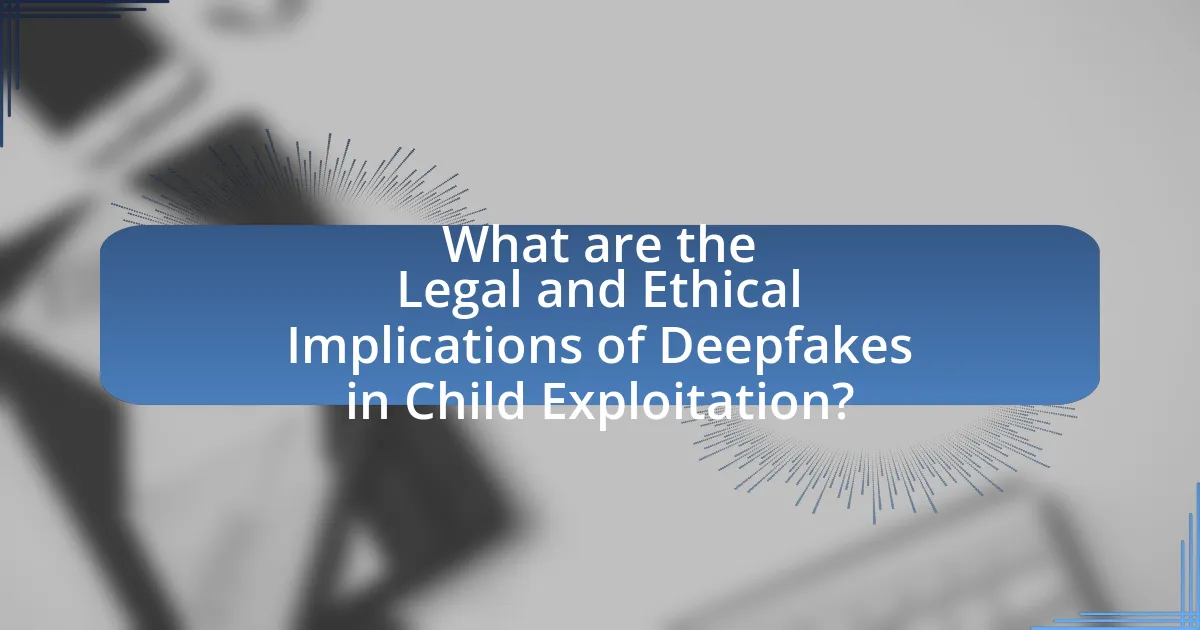
What are the Legal and Ethical Implications of Deepfakes in Child Exploitation?
The legal implications of deepfakes in child exploitation include potential violations of child pornography laws, as deepfakes can create realistic but fabricated images or videos of minors in exploitative situations. Such actions can lead to severe criminal charges, including imprisonment and registration as a sex offender, as established by laws like the PROTECT Act in the United States, which criminalizes the production and distribution of child pornography, including digitally manipulated content.
Ethically, deepfakes raise significant concerns regarding consent, the potential for harm to victims, and the broader societal impact of normalizing such technology. The creation and dissemination of deepfake content involving children can lead to psychological harm and exploitation, undermining the dignity and rights of minors. Ethical frameworks emphasize the need for accountability and the protection of vulnerable populations, highlighting the responsibility of creators and distributors to consider the implications of their actions.
How do existing laws adapt to the challenges posed by deepfakes?
Existing laws adapt to the challenges posed by deepfakes by incorporating specific provisions that address the misuse of synthetic media. For instance, several jurisdictions have enacted legislation that criminalizes the creation and distribution of deepfake content intended to harm individuals, particularly in cases of defamation or non-consensual pornography. In 2018, California passed a law making it illegal to use deepfake technology to harm or defraud others, which reflects a growing recognition of the potential for deepfakes to facilitate child exploitation and other criminal activities. Additionally, federal laws, such as the Protecting Children from Online Sexual Exploitation Act, are being evaluated to include provisions that specifically target the use of deepfakes in child exploitation cases, thereby enhancing legal frameworks to address these emerging threats effectively.
What legislative changes are being proposed to address deepfake technology?
Legislative changes proposed to address deepfake technology include the introduction of laws that specifically criminalize the malicious use of deepfakes, particularly in contexts such as child exploitation and non-consensual pornography. For instance, several U.S. states are considering bills that would make it illegal to create or distribute deepfake content without consent, with penalties that may include fines and imprisonment. These proposals aim to enhance existing child exploitation laws by explicitly incorporating provisions that target the use of deepfakes to manipulate or exploit minors, thereby providing law enforcement with clearer tools to combat this emerging threat.
How do courts interpret deepfake-related cases under current laws?
Courts interpret deepfake-related cases under current laws by applying existing legal frameworks, such as defamation, copyright infringement, and privacy laws, to assess the implications of deepfake technology. For instance, in cases involving non-consensual deepfake pornography, courts have recognized the potential for harm and emotional distress, leading to rulings that favor victims under privacy torts. Additionally, some jurisdictions have enacted specific legislation targeting deepfakes, which further guides judicial interpretation. The application of these laws reflects a growing recognition of the unique challenges posed by deepfakes, particularly in relation to consent and the potential for exploitation, as seen in cases where deepfakes are used to manipulate or harm individuals, especially minors.
What ethical considerations arise from the intersection of deepfakes and child exploitation laws?
The ethical considerations arising from the intersection of deepfakes and child exploitation laws include the potential for deepfakes to create realistic but fabricated images or videos of minors, which can lead to the exploitation and abuse of children. This technology can facilitate the production of non-consensual pornography, thereby violating the rights and dignity of minors. Additionally, the use of deepfakes can complicate legal frameworks, as existing child exploitation laws may not adequately address the nuances of digital manipulation, leading to challenges in prosecution and enforcement. The ethical implications also extend to the responsibilities of technology developers and platforms in preventing misuse, as well as the need for robust legal protections to safeguard vulnerable populations from harm.
How can society balance technological advancement with child protection?
Society can balance technological advancement with child protection by implementing robust regulations and fostering collaboration between technology developers and child protection agencies. Effective regulations can include age verification systems and content moderation policies that prevent harmful material from reaching children. For instance, the Children’s Online Privacy Protection Act (COPPA) in the United States mandates parental consent for data collection from children under 13, demonstrating a legal framework that prioritizes child safety in the digital space. Additionally, technology companies can develop tools that detect and flag deepfake content, thereby reducing the risk of exploitation. Collaborative efforts, such as partnerships between tech firms and child advocacy organizations, can lead to innovative solutions that protect children while allowing for technological growth.
What role do tech companies play in preventing deepfake exploitation?
Tech companies play a crucial role in preventing deepfake exploitation by developing detection technologies and implementing content moderation policies. These companies invest in artificial intelligence and machine learning algorithms to identify and flag deepfake content, thereby reducing its spread. For instance, platforms like Facebook and Twitter have established partnerships with academic institutions and research organizations to enhance their detection capabilities. Additionally, tech companies enforce community guidelines that prohibit the sharing of manipulated media, which helps to deter potential abusers. According to a report by the Deepfake Detection Challenge, advancements in detection methods have shown significant improvements, with some algorithms achieving over 90% accuracy in identifying deepfakes.
What are best practices for individuals and organizations to prevent deepfake exploitation?
To prevent deepfake exploitation, individuals and organizations should implement robust verification processes for digital content. This includes using advanced detection tools that analyze video and audio for signs of manipulation, as studies show that AI-based detection methods can identify deepfakes with over 90% accuracy. Additionally, educating users about the risks and signs of deepfakes enhances awareness and critical thinking, which is crucial since a survey by the Pew Research Center found that 51% of Americans are unaware of deepfake technology. Establishing clear policies and guidelines for content sharing within organizations can also mitigate risks, as organizations that enforce strict content verification protocols significantly reduce the likelihood of deepfake-related incidents.
